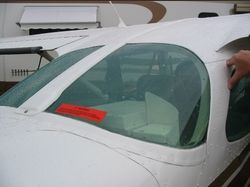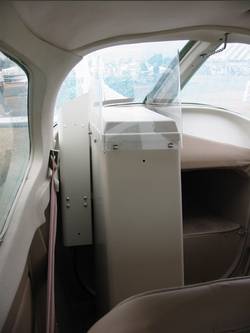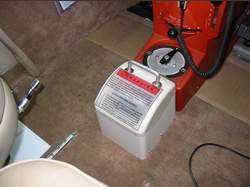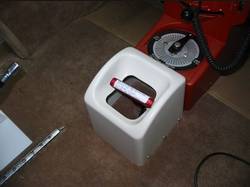By ANN Correspondent Kevin "Hognose" O'Brien
 A
couple of weeks ago at Arlington, ANN was the first (ahem... as
usual) to report that BRS announced that its ballistic recovery
chute was certified for the Cessna 172. While we ran a story at the
time, we have since had a chance to get a good look at the system
in its native element - the Cessna 172.
A
couple of weeks ago at Arlington, ANN was the first (ahem... as
usual) to report that BRS announced that its ballistic recovery
chute was certified for the Cessna 172. While we ran a story at the
time, we have since had a chance to get a good look at the system
in its native element - the Cessna 172.
BRS chose a 1978 Hawk II because it's the heaviest version of
Cessna's venerable machine. "If it works in the heaviest one, it
works in any of them," Dan Johnson says. The complete system exacts
a 79-pound weight penalty. The plane is as neat as you would expect
a factory demonstrator to be. "We bought it like that," Dan told
ANN, "With the paint and interior as it is. We wanted to find a 172
that looks good."
System Components
 The
system consists of the rocket, the parachute assembly, the risers,
and the attachment points. The risers attach at the spar/fuselage
attach points forward, and on the centerline behind the rear
window. The forward attach points are made of steel and wrap around
the spar. The rear attach point is built up; the structure in the
area is not strong enough to bear the stress of a chute deployment
without reinforcement. The BRS installation includes a number of
reinforcements and doublers, which add crucial strength in this
area. Installed, these parts are indistinguishable from the factory
work to which they're attached.
The
system consists of the rocket, the parachute assembly, the risers,
and the attachment points. The risers attach at the spar/fuselage
attach points forward, and on the centerline behind the rear
window. The forward attach points are made of steel and wrap around
the spar. The rear attach point is built up; the structure in the
area is not strong enough to bear the stress of a chute deployment
without reinforcement. The BRS installation includes a number of
reinforcements and doublers, which add crucial strength in this
area. Installed, these parts are indistinguishable from the factory
work to which they're attached.
The rocket and chute are the same ones that are used in the
Cirrus Airplane Parachute System (CAPS). The chute has been tested
at 180 kt and 4,400 pounds, both numbers rather unlikely to show up
in C-172 operations.
The deployment T-bar handle is held in a small console on the
floorboards, aft of the fuel selector. There is a cosmetic/safety
cover over the handle. To deploy the chute, one pulls the plastic
cosmetic cover off (it has a metal handle on it) and then pulls the
T-bar.
Functioning
 Once
you pull that T-bar, things happen fast. The rocket fires, blasting
through the passenger side rear window with a loud WHOOSH. The
rocket has some serious power behind it - if it had no load, it
would be at 30,000 feet when its 1 1/4 seconds of thrust was
over.
Once
you pull that T-bar, things happen fast. The rocket fires, blasting
through the passenger side rear window with a loud WHOOSH. The
rocket has some serious power behind it - if it had no load, it
would be at 30,000 feet when its 1 1/4 seconds of thrust was
over.
The chute can be deployed in any attitude or at any airspeed. It
does need about 250 to 300 feet AGL minimum for full deployment.
But repeated tests have shown that the aircraft can be upright,
inverted, spinning or tumbling - the chute will wind up on top and
the plane on the bottom every time.
Certification
The system required a number of tests to be certified - far
fewer than the Cessna 150 (the first ballistic parachute approved
for a certified airplane) or Cirrus versions. In fact,
certification of the Cirrus chute smoothed the path of the Cessna
172 version, because the FAA sensibly did not require new tests or
documentation for already-certified components.
 Because the installation was similar to the 150/2 version, a
proven quantity, and the chute and rocket were identical to the
Cirrus, BRS didn't have to demonstrate an inflight deployment (as
was done with the 150 and Cirrus). This was welcome news to the
test pilot, said Dan: "You think that firing the chute is
frightening. Imagine sitting there with zero airspeed and knowing
you have to pull that knob and cut the chute away." Of
course, the cut-away knob is only in test machines; on customer
planes, the chute risers are permanently attached to the plane.
Because the installation was similar to the 150/2 version, a
proven quantity, and the chute and rocket were identical to the
Cirrus, BRS didn't have to demonstrate an inflight deployment (as
was done with the 150 and Cirrus). This was welcome news to the
test pilot, said Dan: "You think that firing the chute is
frightening. Imagine sitting there with zero airspeed and knowing
you have to pull that knob and cut the chute away." Of
course, the cut-away knob is only in test machines; on customer
planes, the chute risers are permanently attached to the plane.
What did require a lot of certification is the physical landing.
Here neither the 150 data nor the Cirrus data were much use.
BRS took a 172 airframe, loaded the wings with sand to represent
fuel and lifted it up, and then dropped it.
 BRS
has a video of this test and the video, taken by a high-speed
camera, is eye-opening. The 172 slams onto the ground, and in the
video you can see the extreme flexing of the ill-fated machine's
wings. Despite that, the permanent damage was relatively light.
BRS
has a video of this test and the video, taken by a high-speed
camera, is eye-opening. The 172 slams onto the ground, and in the
video you can see the extreme flexing of the ill-fated machine's
wings. Despite that, the permanent damage was relatively light.
Service
The chute is inspected at routine 100-hour (if required) and
annual inspections. After 10 years, the chute must be repacked and
the rocket replaced. The chute must also be replaced after use
(although that will be the least of your problems by then.
 ANN's Daily Aero-Linx (04.13.24)
ANN's Daily Aero-Linx (04.13.24) ANN's Daily Aero-Term (04.13.24): Beyond Visual Line Of Sight (BVLOS)
ANN's Daily Aero-Term (04.13.24): Beyond Visual Line Of Sight (BVLOS) Airborne 04.09.24: SnF24!, Piper-DeltaHawk!, Fisher Update, Junkers
Airborne 04.09.24: SnF24!, Piper-DeltaHawk!, Fisher Update, Junkers Aero-News: Quote of the Day (04.14.24)
Aero-News: Quote of the Day (04.14.24) ANN's Daily Aero-Term (04.14.24): Maximum Authorized Altitude
ANN's Daily Aero-Term (04.14.24): Maximum Authorized Altitude







